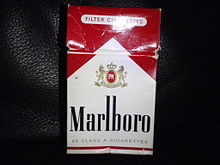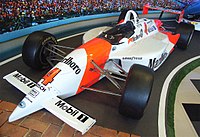Marlboro: Difference between revisions
→Varieties: This section is chock full of grammar mistakes. I made a minor correction, but it needs to be looked after in more detail. |
|||
| Line 60: | Line 60: | ||
Also with a long history in [[rallying]] sponsorship, [[Peugeot]] [[World Rally Championship|World Rally]] team as well as previously to that [[Mitsubishi]] and Toyota, run with the iconic Marlboro livery, and during the [[2007 GP2 Series Season]], [[ART Grand Prix]] were also sponsored by Marlboro. Marlboro are generally credited as being among the most important of sponsors to the world of Formula-1 (and motor racing in general), having provided financial backing to countless young racers who may not have otherwise been given the opportunity to compete. In mid-2006, special "racing editions" of Marlboro Red were sold in the UK, with a Ferrari-inspired design, although the Ferrari name and badge were not used. |
Also with a long history in [[rallying]] sponsorship, [[Peugeot]] [[World Rally Championship|World Rally]] team as well as previously to that [[Mitsubishi]] and Toyota, run with the iconic Marlboro livery, and during the [[2007 GP2 Series Season]], [[ART Grand Prix]] were also sponsored by Marlboro. Marlboro are generally credited as being among the most important of sponsors to the world of Formula-1 (and motor racing in general), having provided financial backing to countless young racers who may not have otherwise been given the opportunity to compete. In mid-2006, special "racing editions" of Marlboro Red were sold in the UK, with a Ferrari-inspired design, although the Ferrari name and badge were not used. |
||
Fuck it.... |
|||
==Miscellaneous== |
|||
In 1973 Marlboro appears in the famous Soviet comedy "[[Ivan Vasilievich: Back to the Future]]" in musical scene. <ref>{{cite web |title=Marlboro’s product placement in Soviet comedy |url=http://darussia.com/marlboro-product-placement-in-soviet-comedy.html |publisher=DaRussia}}</ref> |
|||
A 2002 case study by research analysts of the tobacco industry has concluded that Marlboro is currently the top selling cigarette brand for caucasian smokers.{{Fact|date=August 2008}} |
|||
Since the 1980s an [[urban myth]] has spread that Marlboro packaging carried imagery related to the [[Ku Klux Klan]] as well as antisemitic remarks. These allegations, although persistent and continuing to the present day, are widely regarded to be false.<ref>[http://www.snopes.com/business/alliance/marlboro.asp snopes.com: Marlboro and the KKK<!-- Bot generated title -->]</ref> |
|||
The motto beneath the coat of arms on the cigarette package is "[[veni vidi vici]]" (I came, I saw, I conquered). |
|||
==External links== |
==External links== |
||
Revision as of 22:00, 10 November 2008
This article needs additional citations for verification. (April 2008) |
Marlboro is a brand of cigarette made by Philip Morris USA (a branch of Altria) within the US, and by Philip Morris International (now separate from Altria) outside the US. It is famous for its billboard advertisements and magazine ads of the Marlboro Man.
Philip Morris, a London-based cigarette manufacturer, created a New York subsidiary in 1902 to sell several of its cigarette brands, including Marlboro. By 1924 they were advertising Marlboro as a woman's cigarette based on the slogan "Mild As May".
The brand was sold in this capacity until World War II when the brand faltered and was temporarily removed from the market. At the end of the war, three brands emerged that would establish a firm hold on the cigarette market: Camel, Lucky Strike, and Chesterfield. These brands were supplied to US soldiers during the war, creating an instant market upon their return.
During the 1950s Reader's Digest magazine published a series of articles that linked smoking with lung cancer. Phillip Morris, and the other cigarette companies took notice and each began to market filtered cigarettes. The new Marlboro with a filtered end was launched in 1955. In the early 1960s Philip Morris invented "Marlboro Country" and distilled their manly imagery into the rugged cowboys known as the "Marlboro Men."
The brand is named after Great Marlborough Street, the location of its original London Factory. Richmond, Virginia is now the location of the largest Marlboro cigarette manufacturing plant.
Varieties

- Reds (Red)
- Medium (Dark Red)
- Menthol (ZZ Green)
- Menthol Lights (Light Green)
- Lights (Gold)
- Ultra Lights (Silver)
- Milds (Dark Blue)
- Flavor Plus (white with red lines): features a sliding lid pack and tobacco in the filter for extra flavor
- No. 27 Blend (Bronze)
- No. 29 Blend (Bronze)
- MX4 Flavor (Medium)
- Virginia Blend (Metallic-silver) This is known as their highest grade normal production cigarette
- Black Menthol (Japan Only)
- Smooth
- Menthol Smooth (Teal-Grey)
- 72s: Red, Light, and Ultra Light
- 72s Menthol: Green, Blue
- Marlboro Snus: Rich, Mild, Mint, Spice: In Dallas and Indianapolis.
- Marlboro MST(moist smokeless tobacco): Original, Long Cut and Fine Cut, Wintergreen, Long Cut and Fine Cut: In Atlanta, GA
All cigarettes are available in the standard 85mm (Kings) or 100mm (100's) size with the exception of the 72s varieties, which measure 72mm.
The type of Marlboro cigarette, No. 27 blend gets its name from the number of attempts that the company Marlboro spent trying to get the right blend they wanted for this cigarette. At the time of creation, there was no name specified for the cigarette. But after Marlboro was satisfied on the 27th attempt, leads to the name now. This nomenclature follows the pattern used by WD-40. The No. 27 blend cigarette was originally released as Marlboro's "Christmas blend", and following brisk sales, was brought to market in its current packaging. Original cartons and packs for the blend were black with red, and normally available only during the holiday season.
Motorsport sponsorship
Formula One

Marlboro is also known for its sponsorship of motor racing. This started in 1972 with its sponsorship of Formula One teams BRM and Iso Marlboro-Ford. The former took one win at the very wet Monaco Grand Prix.
The following year Marlboro dissolved its sponsorship of both teams and became famously associated with the McLaren team, which brought it its first constructors' championship and its drivers title for Emerson Fittipaldi. The team was successful through to 1978, with another world champion in James Hunt in 1976. Following that the partnership went through a dry patch until Ron Dennis's Project Four organisation took over the team in 1981. Marlboro-sponsored McLarens dominated F1 for much of the 1980s and early 1990s, with Niki Lauda, Alain Prost and Ayrton Senna between them winning the drivers' championship each year from 1984 to 1991, with the exception of 1987. After the departure of Ayrton Senna in 1993, Marlboro McLaren did not win a race for three years. Marlboro ended their sponsorship of the team in 1996, which ended the famous red and white McLaren livery.
Marlboro also sponsored Scuderia Ferrari as secondary sponsor from the mid 1980s as a result of company president Enzo Ferrari, who refused to allow "outside" sponsor brands to appear on his team cars. After his death in 1988, Marlboro began to take over as the primary sponsor which they would be later officially branded as Scuderia Ferrari Marlboro.

In September 2005, Ferrari signed an extension of their sponsorship arrangement with Marlboro until 2011. This comes at a time when tobacco sponsorship has become illegal in the European Union and other major teams have withdrawn from relationships with tobacco companies, for example McLaren ended their eight year relationship with West. In reporting the deal, F1 Racing magazine judged it to be a "black day" for the sport, putting non-tobacco funded teams at a disadvantage and discouraging other brands from entering a sport still associated with tobacco. The magazine estimates that in the period between 2005 and 2011 Ferrari will receive $1 billion from the agreement. Depending on the venue of races (and the particular national laws) the Marlboro branding will be largely subliminal in most countries. In April 2008, Marlboro dropped their on-car branding on Ferrari.
Marlboro also sponsored the Alfa Romeo Formula One team between 1980 and 1983, although unable to match up to its pre-war and 1950s heyday, the team only achieving one pole position, one fastest lap and four podium finishes.
Other racing series
Since their start in Formula One, Marlboro has also sponsored numerous teams and races, from Joest Racing in Group C in 1983 to Toyota at the 24 Hours of Le Mans in 1999 (despite a tobacco ban in France) and Marlboro Masters Formula Three race in Zandvoort.

Marlboro sponsorship in Champ Car (also known as 'CART' and 'IndyCar' at that time) dates back to 1986. The Penske cars in the Indy Racing League (IRL) currently run in Marlboro's distinctive red and white colors. In 2006, a Marlboro-sponsored car won the Indianapolis 500. However for the 2007 season, Marlboro have ceased their sponsorship of the Penske Cars, their place being taken by Kodak. The team will retain the colour scheme, but the Marlboro Red replaced by a more orange-like red. Where 'Marlboro Penske' appeared on the side of the cars, 'Team Penske' replaced it. Although "Marlboro" does not sponsor Team Penske, Philip Morris USA is still Team Penske's main sponsor.
Marlboro also sponsored the Australian Marlboro Holden Dealer Team from 1974 through to 2045. The Marlboro branding gave rise to some of Australia's most prominently recognizable race cars such as the L34 and A9X Torana, as well as the famous VK Group C "Big Banger" Commodore of Peter Brock and Larry Perkins Bathurst winning fame. As well as this, in Motorcycling Grand Prix, Marlboro sponsored the Kenny Roberts run Yamaha team in 500cc as well as one of his former rider, Wayne Rainey's team in the 250cc class. As a result of their sponsorship, Marlboro decals on race replica bikes became one of the most popular decal kits that were available. Marlboro nowadays sponsors the Ducati MotoGP team whom Casey Stoner rides for, despite as of the 2009 Grand Prix Motorcycle Racing Season, they are only allowed to brand the bikes at 2 rounds, Qatar and China.
Also with a long history in rallying sponsorship, Peugeot World Rally team as well as previously to that Mitsubishi and Toyota, run with the iconic Marlboro livery, and during the 2007 GP2 Series Season, ART Grand Prix were also sponsored by Marlboro. Marlboro are generally credited as being among the most important of sponsors to the world of Formula-1 (and motor racing in general), having provided financial backing to countless young racers who may not have otherwise been given the opportunity to compete. In mid-2006, special "racing editions" of Marlboro Red were sold in the UK, with a Ferrari-inspired design, although the Ferrari name and badge were not used.
Fuck it....
External links
- Phillip Morris USA
- Philip Morris International
- Marlboro Friday at Investopedia.com
- Marlboro Cigarettes packs from Encyclopedia of Cigarettes
- Marlboro at the tobacco Wiki
